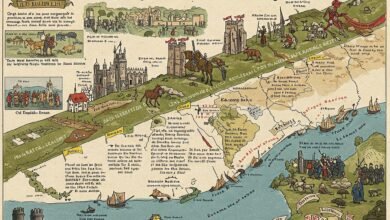10 Must-Visit Places in Morocco That Americans Love

Introduction to Morocco: A Land of Diversity
Morocco, a captivating country located in North Africa, offers a unique blend of cultures, rich history, and stunning geographical diversity that attracts visitors from around the world, including a significant number of Americans. This remarkable destination serves as a crossroads between Europe and Africa, with its proximity to the Mediterranean Sea and the Atlantic Ocean, making it a vital hub for trade, culture, and tourism.
The cultural tapestry of Morocco is woven together from various influences, including Berber, Arab, and French heritages. This mélange is evident in the country’s architecture, cuisine, and vibrant traditions, providing travelers with a multifaceted experience. American visitors often find themselves enchanted by the eclectic markets, known as souks, which offer an array of colorful textiles, intricate pottery, and fragrant spices. Such experiences highlight Morocco’s status as a nation that celebrates its history while embracing modernity.
Moreover, Morocco’s geographical diversity adds to its allure. Tourists can explore the vast Sahara Desert, with its breathtaking dunes and starry nights, as well as the rugged Atlas Mountains, which offer incredible trekking opportunities and picturesque landscapes. The coastal towns of Essaouira and Agadir provide a serene atmosphere along the shore, contrasting sharply with the bustling urban life of cities like Marrakech and Casablanca.
Equally deserving of mention is the warmth and hospitality of the Moroccan people. Known for their welcoming nature, Moroccans take pride in their cultural heritage and are eager to share it with visitors. This friendly environment creates a memorable experience for American travelers, as they find themselves immersed not only in Morocco’s stunning scenery but also in the local customs and traditions. It is this unique combination of cultural richness, historical depth, and natural beauty that has made Morocco an increasingly popular travel destination for Americans.
Marrakech: The Red City
Marrakech, often referred to as the Red City due to the distinctive red hue of its buildings and ramparts, is a vibrant metropolis that offers a fascinating blend of history, culture, and modernity. One of the most iconic landmarks in Marrakech is the Koutoubia Mosque, a stunning example of traditional Moroccan architecture. This mosque, which dates back to the 12th century, is renowned for its 77-meter-tall minaret and serves as a focal point in the city’s skyline. Non-Muslims are not permitted inside, but the exterior provides ample opportunity for photography and appreciation of its intricate details.
The heart of Marrakech is undoubtedly the bustling Jemaa el-Fnaa square, where locals and tourists alike congregate to experience the city’s dynamic atmosphere. From snake charmers and musicians to vibrant food stalls offering a tantalizing array of traditional Moroccan cuisine, the square is a hub of energy that captivates visitors. Sampling local dishes such as tagine, couscous, and pastilla from the street vendors offers an authentic taste of Moroccan flavors, contributing to the city’s immersive cultural experience.
In addition to the lively square, the Jardin Majorelle is a must-visit oasis that showcases a stunning collection of exotic plants and vibrant colors. Designed by French painter Jacques Majorelle in the 1920s, the garden is a serene escape from the bustling streets. Nearby, the Saadian Tombs, dating back to the late 16th century, offer insight into the dynasty’s royal history and ornate burial practices. Navigating the medina’s narrow alleyways reveals a maze of artisanal shops and vibrant souks, where visitors can purchase handicrafts, textiles, and spices, further enriching the experience of this enchanting city.
Fes: The Cultural Capital
Fes, often referred to as the cultural capital of Morocco, boasts a rich history that continues to attract visitors from around the globe. The city is renowned for its UNESCO-listed medina, a labyrinthine district filled with narrow alleys and ancient architecture that showcases the intricate craftsmanship of Moroccan artisans. Walking through the medina of Fes el-Bali, one can experience a living museum of traditional Moroccan life and culture, with its vibrant souks brimming with handmade goods, textiles, and ceramics.
The architectural beauty of Fes is evident in its stunning palaces, mosques, and madrasas, which reflect a blend of Arab, Berber, and French colonial influences. Notable sites such as the Bou Inania Madrasa and the Al-Qarawiyyin Mosque, the latter claiming to be the oldest existing degree-granting university in the world, highlight the city’s longstanding significance as a center of Islamic learning. These historical landmarks are not only architectural marvels but also serve as vital links to Morocco’s illustrious past.
Moreover, Fes is famous for its tanneries, particularly the Chouara Tannery, where the ancient methods of leather tanning are still practiced today. Visitors often find the sight both fascinating and overwhelming, with its vivid array of dyed leathers soaking in large vats. This process is emblematic of Fes’s enduring artisanal traditions, where craftsmanship thrives amidst modernity. The tanneries not only offer a glimpse into the labor-intensive trade but also underscore the importance of Fes as a hub of traditional Moroccan craftsmanship.
The allure of Fes lies not just in its historical significance, but also in the cultural experiences it offers. From local artisans showcasing their skills to the vibrant festivals celebrated throughout the year, the city remains a pivotal point for those seeking to immerse themselves in Moroccan culture. Its deep-rooted traditions and emphasis on education make Fes an indispensable destination for anyone looking to grasp the essence of Morocco.
Cabo Verde: An Overview
Chefchaouen, often referred to as “The Blue Pearl,” is a picturesque town nestled in the Rif Mountains of Morocco. Renowned for its striking blue-washed buildings, Chefchaouen presents a unique ambiance that captivates many visitors, particularly from the United States. The town’s vibrant hues are credited to its historical connection to Jewish exiles who sought refuge here, infusing the local architecture with elements of both Moroccan and Andalusian styles. Strolling through the narrow, winding streets, visitors can immerse themselves in a serene atmosphere complemented by the stunning natural landscapes that surround the town.
Adventure enthusiasts will find numerous hiking opportunities in the vicinity of Chefchaouen. The Rif Mountains offer trails that cater to various skill levels, providing options ranging from leisurely walks to more challenging treks. Among the popular trails, the hike to the iconic Akchour Waterfalls is particularly favored. This picturesque location, characterized by cascading water and lush greenery, serves as a perfect setting for nature lovers and photographers alike.
Beyond its breathtaking views and outdoor activities, Chefchaouen also boasts a thriving local market scene. The souks, or traditional markets, brim with handmade crafts, textiles, and local goods. Visitors should be prepared to engage with vendors, as bargaining is a customary practice. These markets offer a glimpse into the authentic Moroccan lifestyle, allowing visitors to support local artisans and take home unique souvenirs. For those interested in photography, early mornings or late afternoons provide the best light for capturing the stunning architecture and vibrant colors of the town, creating lasting memories of this enchanting destination.
The Sahara Desert: An Adventure Awaits
The Sahara Desert, a vast expanse of golden dunes and mystical landscapes, offers a unique and adventurous experience that attracts travelers from all around the globe. For Americans seeking an unforgettable journey, the enchanting beauty of the Sahara provides an array of activities that are sure to leave lasting memories. One of the most popular ways to explore this captivating landscape is through camel trekking. Riding these gentle giants, visitors traverse the undulating sand dunes, immersing themselves in the tranquility and grandeur of this iconic desert.
As the sun sets, casting a warm glow over the erg Chebbi dunes, the desert transforms into a breathtaking spectacle. The serene environment creates the perfect setting for stargazing, allowing travelers to marvel at the unspoiled night sky, dotted with countless stars. This celestial experience is indeed a highlight of any Sahara adventure, as the desert’s clear air offers one of the best views of the Milky Way.
For those seeking an adrenaline rush, sandboarding down the massive dunes provides an exhilarating alternative. This thrilling activity allows adventurers to ride the sandy slopes, offering a different perspective on the desert’s vastness. Furthermore, an overnight stay in a traditional desert camp is an essential part of the Sahara experience. Guests are invited to relish authentic Moroccan cuisine while enjoying traditional music around a desert campfire, all under the endless expanse of the starry sky.
The Sahara is not just a natural wonder but also holds significant cultural importance in Moroccan society. Its rich history is intertwined with the Berber people, who have called this desert home for centuries. The cultural elements found in the region enhance the tourism experience, making the Sahara Desert a must-visit destination for Americans and international travelers alike.
Essaouira: The Coastal Gem
Essaouira is one of Morocco’s most captivating coastal cities, offering a unique blend of historical significance and natural beauty that appeals to various travelers, especially Americans. Known for its stunning medina, a UNESCO World Heritage site, Essaouira is characterized by its whitewashed buildings and blue accents, creating a picturesque setting that enchants visitors. The city’s architecture is a testament to its rich history, influenced by Portuguese and Berber cultures.
For beach lovers, Essaouira provides an array of activities that enhance its appeal as a coastal retreat. The expansive sandy beaches are perfect for sunbathing, while the Atlantic winds create ideal conditions for windsurfers and kite surfers, making it a favored destination for adventure enthusiasts. Whether one is a novice or an experienced windsurfer, Essaouira’s favorable weather conditions cater to all skill levels, offering the thrill of sport alongside stunning views of the ocean.
Moreover, the seafood cuisine in Essaouira is not to be overlooked. The city’s port is bustling with fishermen bringing in their daily catch, which results in a vibrant culinary scene. Visitors can indulge in fresh seafood at the local restaurants, where dishes like grilled sardines and mixed seafood platters are a must-try. These dining experiences are often accompanied by breathtaking views of the beachfront, enhancing the overall enjoyment of the meal.
The arts scene in Essaouira further enriches its cultural tapestry. The city hosts a variety of festivals, with the Gnaoua Festival being one of the highlights. This famous event celebrates the rich musical heritage of the Gnaoua culture, attracting artists and crowds from around the globe. The festival showcases world-class performances that promote cultural exchange, making Essaouira a central hub for art lovers. In addition, numerous galleries and artisan shops line the streets, offering visitors unique handcrafted goods that reflect the region’s vibrant artistry.
Casablanca: Modernity Meets Tradition
Casablanca, Morocco’s largest city, stands as a vibrant blend of modernity and tradition, making it a favored destination for many travelers, particularly from the United States. The city is known for its impressive skyline, yet it is steeped in rich cultural history that attracts visitors looking to experience the essence of Moroccan life.
At the heart of Casablanca lies the stunning Hassan II Mosque, a remarkable architectural feat that captivates all who visit. This mosque is one of the few in Morocco open to non-Muslims and offers guided tours. Its minaret, towering at a height of 210 meters, is the tallest religious structure in the world, providing breathtaking views of the Atlantic Ocean. The intricate tile work and carvings reveal the exquisite craftsmanship emblematic of Moroccan artistry, making it a must-visit for anyone in the region.
The Royal Palace, another architectural gem, reflects the grandeur of Moroccan heritage. While the palace grounds are not accessible to the public, its exterior showcases beautiful gardens and traditional architecture, leaving a lasting impression on all who pass by. Visitors often admire the surrounding neighborhoods that are steeped in culture, where artisans display their handcrafted goods in bustling markets.
<pcasablanca’s
Moreover, shopping enthusiasts can explore the vibrant markets, known as souks, where they can find everything from traditional rugs to unique pottery. The combination of modern shopping centers and traditional open-air markets enhances the city’s eclectic charm, presenting the best of both worlds.
Casablanca’s unique blend of contemporary elements and deep-rooted traditions defines its character, making it a key part of any journey through Morocco.
Rabat: The Capital City
Rabat, the capital city of Morocco, is a remarkable destination that beautifully encapsulates the country’s rich history and cultural diversity. As the political and administrative center of Morocco, Rabat not only functions as a hub for government activities but also offers visitors a profound glimpse into the heart of Moroccan heritage. The city is home to several historical landmarks, including the Oudayas Kasbah and the iconic Hassan Tower, both of which epitomize the architectural elegance of the past.
The Oudayas Kasbah is a picturesque fortress overlooking the Bou Regreg River, characterized by its vibrant blue and white houses. This site is not only calming to the eye but also steeped in history, making it a must-visit for any traveler. The intricate design of its walls and the beautiful gardens within enhance the inviting atmosphere of this historical site. Just a short distance away, the Hassan Tower stands as a testament to Muslim architecture. Originally intended to be the largest minaret in the world, its incomplete structure tells stories of ambition and devotion from the 12th century.
In addition to its historical significance, Rabat is also home to various cultural attractions, including museums, gardens, and art galleries. The Mohammed VI Museum of Modern and Contemporary Art showcases a stunning collection of Moroccan art, while the expansive Andalusian Gardens provide a serene escape from the bustling city. This unique blend of modern conveniences with traditional roots creates a fascinating dynamic, inviting visitors to explore both the historical and modern aspects of Rabat.
Travelers to Rabat will find a city that not only embraces its past but also looks ahead, making it an essential destination for those wishing to experience Morocco’s profound cultural narrative.
Atlas Mountains: Nature’s Masterpiece
The Atlas Mountains, a prominent range in North Africa, stretch across Morocco and offer a remarkable display of nature’s beauty. Known for their striking landscapes and diverse ecosystems, these mountains provide a striking contrast to the arid expanses of the surrounding deserts, making them a haven for nature enthusiasts and adventure seekers alike. The Atlas Mountains are distinguished by their jagged peaks, lush valleys, and tranquil Berber villages, each contributing to the unique charm of the region.
Hiking in the Atlas Mountains is a popular activity, attracting many visitors eager to explore breathtaking trails. One of the most famous trails is the ascent to Toubkal, the highest peak in North Africa. This trek is suitable for experienced hikers, offering panoramic views that showcase the dramatic landscape. However, there are numerous other hiking paths that cater to varying skill levels. Less-traveled routes, such as the trek to the secluded Cascade d’Ouzoud, provide a chance to witness stunning waterfalls and vibrant flora while experiencing the serenity of nature, away from the bustling tourist spots.
In addition to hiking, the Atlas Mountains are home to several Berber villages, offering a rare glimpse into the traditional lifestyles of the local inhabitants. Visitors can engage with the locals, learning about their customs, crafts, and cuisine, which often includes hearty tagines and refreshing mint tea. The rich cultural experience complements the stunning natural beauty and is often a highlight for those venturing into this mountainous region.
For travelers wishing to explore lesser-known trails, paths around the Imlil and Aït Bouguemez valleys present hidden gems of unparalleled beauty. These trails lead through diverse landscapes, from lush orchards to rocky terrains, offering unique opportunities for photography and introspection. The Atlas Mountains stand as a testament to nature’s artistry, inviting adventurers to immerse themselves in their splendor.
Conclusion: The Moroccan Experience
Morocco offers a vibrant tapestry of experiences that cater to a wide array of interests, making it an ideal travel destination for Americans. From the bustling markets of Marrakech to the serene deserts of the Sahara, each location embodies a distinct character that captivates visitors. The rich cultural heritage, which includes influences from Berber, Arab, and French cultures, can be experienced through the traditions, art, and architecture found throughout the country.
For those seeking adventure, the Atlas Mountains provide exhilarating hiking opportunities, while the coastal city of Essaouira invites travelers to explore the stunning beach scenery and partake in water sports. Food enthusiasts are rewarded with a culinary journey where spices, tagines, and diverse street food reflect the country’s rich gastronomical history. Meanwhile, history buffs can delve into Morocco’s storied past by visiting ancient cities such as Fes and Meknes, where every corner holds a piece of the country’s heritage.
This unique combination of culture, adventure, history, and gastronomy allows travelers to craft personalized itineraries that suit their passions. As exploration unfolds in this enchanting land, visitors are likely to create lifelong memories filled with breathtaking landscapes and warm hospitality. We encourage readers to consider their own travel aspirations and to embrace the Moroccan experience fully. Whether you’ve already visited or are planning your first trip, sharing your experiences can inspire others to discover Morocco’s wonders. Take the first step in crafting your unique Moroccan adventure, and make sure to immerse yourself in everything this extraordinary country has to offer.






















